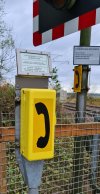Killingworth
Established Member
Sometimes one has to laugh at oneself, like sitting for 25 minutes yesterday waiting for the barriers to rise at Smeafield crossing in Northumberland. Every 3 minutes or so a train to watch. LNER, LUMO, XC and finally a 3 car Scotrail. RTT then says nothing for 15 minutes but still they didn't rise.
By now there are cars waiting patiently on both sides. So I walked forward to the gates and found the phone hiding behind a hedge. Voice from other end with words to the effect "I wondered when anyone was going to call, the barriers are jammed". Seems we'd been seen on cctv and he was already well aware of the situation.
So our intended drive south along the Coastal Route was aborted and back to the A1 and direct route to our destination. As we drove away a Network Rsil incident vehicle waa approaching.
Amusing for us,, but clearly others were not so understanding. There seems to be no easy way to make road users aware of such a situation until someone loses patience and seeks out the phone. In this case it was easy to tell those waiting behind me and all turned to find another route.. Those waiting on the other side seemed to want to carry on waiting. Hopefully the fault was soon cleared.
How quickly should a barrier reopen if there are trains every 3 minutes?
How quickly should appropriate signage be put in place to advise road users of a broken crossing? In rural situations it could be some time.
Whatever, it was interesting to see drivers patiently waiting for the barriers to rise. A contrast with the stories of smashed barriers by those too impatient to wait.
By now there are cars waiting patiently on both sides. So I walked forward to the gates and found the phone hiding behind a hedge. Voice from other end with words to the effect "I wondered when anyone was going to call, the barriers are jammed". Seems we'd been seen on cctv and he was already well aware of the situation.
So our intended drive south along the Coastal Route was aborted and back to the A1 and direct route to our destination. As we drove away a Network Rsil incident vehicle waa approaching.
Amusing for us,, but clearly others were not so understanding. There seems to be no easy way to make road users aware of such a situation until someone loses patience and seeks out the phone. In this case it was easy to tell those waiting behind me and all turned to find another route.. Those waiting on the other side seemed to want to carry on waiting. Hopefully the fault was soon cleared.
How quickly should a barrier reopen if there are trains every 3 minutes?
How quickly should appropriate signage be put in place to advise road users of a broken crossing? In rural situations it could be some time.
Whatever, it was interesting to see drivers patiently waiting for the barriers to rise. A contrast with the stories of smashed barriers by those too impatient to wait.
Last edited:

